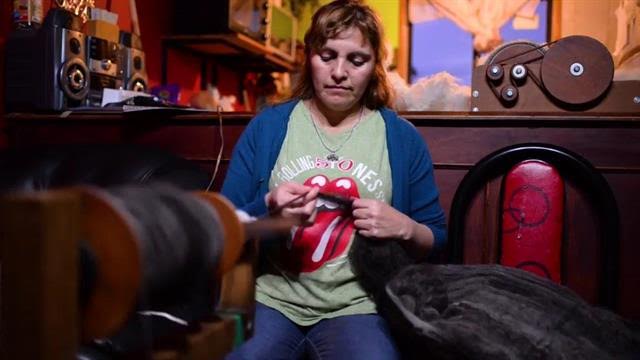Argentina – Women Spinners “at the End of the World” Reclaim Traditional Wool Spinning & Dyeing
By Heather
Brady, WUNRN, May 7, 2018
At
the southernmost
tip of South America, a group of women are working together to keep
alive their cultural tradition of spinning and weaving wool for clothing.
the southernmost
tip of South America, a group of women are working together to keep
alive their cultural tradition of spinning and weaving wool for clothing.
 |
|
Photographs
by Luján Agusti |
These
women call themselves hilanderas del fin de mundo, or “spinners at the end
of the world,” and they spin, stain, and weave local sheep’s wool in
Argentina’s Tierra del
Fuego region, where the process has been passed down through
generations of families.
Rosa
Ayanquituy works the wool through her hands as she spins it into shape.
Ayanquituy works the wool through her hands as she spins it into shape.
The women
are mostly between 40 and 80 years old, though some of their younger siblings
have shown an interest in learning and participated in the process. In many
cases, the women learned techniques for spinning and weaving sheep’s wool when
they were young, making their own clothing when they were girls.
are mostly between 40 and 80 years old, though some of their younger siblings
have shown an interest in learning and participated in the process. In many
cases, the women learned techniques for spinning and weaving sheep’s wool when
they were young, making their own clothing when they were girls.
Their hands weave
garments that reflect the colors of their surroundings, which
can be harsh and unpredictable. They use white to represent snow and red,
orange, yellow, and green to represent autumn.
garments that reflect the colors of their surroundings, which
can be harsh and unpredictable. They use white to represent snow and red,
orange, yellow, and green to represent autumn.
“Each
piece of clothing and object we make carries with it a story that refers to the
place where it was made—its landscape, its nature, the warmth with which the
hands of these women spin and weave despite the inclement weather in the end of
the world,” says Norma Enriquez, the leader of the hilanderas community.
“Each garment carries with it the immensity of Tierra del Fuego, a big respect
for nature and for our own history.”
piece of clothing and object we make carries with it a story that refers to the
place where it was made—its landscape, its nature, the warmth with which the
hands of these women spin and weave despite the inclement weather in the end of
the world,” says Norma Enriquez, the leader of the hilanderas community.
“Each garment carries with it the immensity of Tierra del Fuego, a big respect
for nature and for our own history.”
The dyes
for the wool are made from leaves, flowers, fruits, barks, and roots the women
collect, taking care to protect nature as much as they can and use their
knowledge of native plants to gather the best local materials possible. The
materials are then boiled and mixed to make vividly colored dyes, and the women
use their time-tested process of soaking the wool in the boiling dye to achieve
the colors they want. The wool, which is washed and spun before it’s dyed, is
then rolled up and left to dry before the hilanderas will begin weaving with
it.
for the wool are made from leaves, flowers, fruits, barks, and roots the women
collect, taking care to protect nature as much as they can and use their
knowledge of native plants to gather the best local materials possible. The
materials are then boiled and mixed to make vividly colored dyes, and the women
use their time-tested process of soaking the wool in the boiling dye to achieve
the colors they want. The wool, which is washed and spun before it’s dyed, is
then rolled up and left to dry before the hilanderas will begin weaving with
it.
The women
have been industrious in selling their clothing and wool at local markets,
receiving support from INTA Ushuaia (Instituto Nacional de Tecnología
Agropecuaria) members who provide logistical and technical support, training,
and education about the diverse qualities of sheep’s wool. In addition, the
project was founded with support from the Tierra del Fuego government.
have been industrious in selling their clothing and wool at local markets,
receiving support from INTA Ushuaia (Instituto Nacional de Tecnología
Agropecuaria) members who provide logistical and technical support, training,
and education about the diverse qualities of sheep’s wool. In addition, the
project was founded with support from the Tierra del Fuego government.
Enriquez
says it was hard at first to insert the group’s products into the life of the
community in the region, but after working at fairs, using radio and television
to advertise, and making two short films about the group’s beginning, their
reputation became more widely known and they’ve experienced more success.
says it was hard at first to insert the group’s products into the life of the
community in the region, but after working at fairs, using radio and television
to advertise, and making two short films about the group’s beginning, their
reputation became more widely known and they’ve experienced more success.


